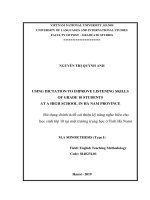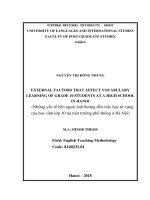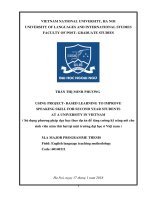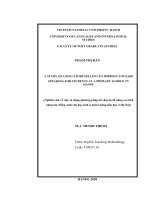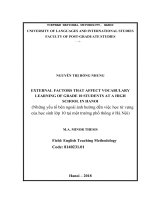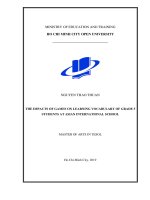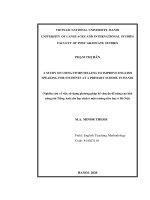Effect of pictures story telling on speaking skill of grade 5 students at a primary school master of TESOL
Bạn đang xem bản rút gọn của tài liệu. Xem và tải ngay bản đầy đủ của tài liệu tại đây (1.49 MB, 109 trang )
MINISTRY OF EDUCATION AND TRAINING
BA RIA-VUNG TAU UNIVERSITY
----------------------------
THESIS
DO NGUYEN NHAT THANH
EFFECT OF PICTURES STORY TELLING
ON SPEAKING SKILL OF GRADE 5
STUDENTS AT A PRIMARY SCHOOL
Ba Ria-Vung Tau - Year 2022
MINISTRY OF EDUCATION AND TRAINING
BA RIA-VUNG TAU UNIVERSITY
----------------------------
THESIS
EFFECT OF PICTURES STORY TELLING
ON SPEAKING SKILL OF GRADE 5
STUDENTS AT A PRIMARY SCHOOL
Submitted to the Postgraduate Institute in partial fulfillment
of the Master’s degree in TESOL
Course code: 8140111
By
Do Nguyen Nhat Thanh
Supervised by
LE HUONG HOA Ph.D.
Ba Ria-Vung Tau -Year 2021
i
STATEMENT OF ORIGINAL AUTHORSHIP
The work contained in this thesis has not been previously submitted to meet
requirements for an award at this or any other higher education institution. To the
best of my knowledge and belief, the thesis contains no material previously published
or written by another person except where due reference is made.
Signature:
_________________________
Date:
_________________________
ii
ACKNOWLEDGEMENTS
First and foremost, I am extremely grateful to my supervisor, Ms. LE HUONG
HOA. Ph.D., for her invaluable advice, continuous support, and patience during my
study. Her immense knowledge and plentiful experience have encouraged me in all
the time of my academic research and daily life.
I would also like to thank the instructors at Ba Ria-Vung Tau University for
their great useful knowledge through university courses. Furthermore, I would like to
thank all the teachers and students at Dinh Tien Hoang Primary School for their
supports and willingness to participate in the study. It is their kind help and support
that have made my study a wonderful time.
Finally, I would like to express my gratitude to my parents and my friends.
Without their tremendous understanding and encouragement in the past few years, it
would be impossible for me to complete my study.
iii
TABLE OF CONTENTS
Statement of Original Authorship ............................................................... i
Acknowledgements .................................................................................... ii
List of Abbreviations ................................................................................ vi
List of Tables ........................................................................................... vii
List of Figures ......................................................................................... viii
Abstract ..................................................................................................... ix
CHAPTER 1: INTRODUCTION .......................................................... 1
1.1 Rationale of the study .......................................................................... 1
1.2 Aims and objectives of the study ......................................................... 4
1.3 Research questions ............................................................................... 4
1.4 Significance of the study...................................................................... 4
1.5 Scope of the study ................................................................................ 5
1.6 Structure of the study ........................................................................... 5
CHAPTER 2: LITERATURE REVIEW .............................................. 6
2.1Speaking skills ...................................................................................... 6
2.1.1 Definition .......................................................................................... 6
2.1.2 The importance of speaking skills .................................................... 7
2.1.3 The components of speaking skills ................................................... 8
2.1.4 Features of speaking ......................................................................... 9
2.2 Teaching speaking skills .................................................................... 11
2.2.1. The notion of teaching speaking skills .......................................... 11
iv
2.2.2 The activities to promote speaking skills........................................ 11
2.3 Concept of pictures storytelling ......................................................... 14
2.3.1 Picture ............................................................................................. 14
2.3.2 Storytelling...................................................................................... 17
2.3.3 The benefits of pictures storytelling ............................................... 18
2.4 Using pictures storytelling in teaching speaking skills ..................... 19
2.5 Previous studies ................................................................................. 21
2.6 Chapter summary ............................................................................... 23
CHAPTER 3: RESEARCH METHODOLOGY ................................ 24
3.1 Research setting ................................................................................. 24
3.2 Research design ................................................................................. 25
3.3 Research participants ......................................................................... 26
3.4 Research instruments ......................................................................... 27
3.4.1 Pre-test and post -test ...................................................................... 27
3.4.2 Questionnaire .................................................................................. 28
3.4.3 Observation checklist ...................................................................... 29
3.5 Data collection procedures................................................................. 30
3.6 Data analysis ...................................................................................... 41
3.7 Chapter summary ............................................................................... 43
CHAPTER 4: FINDINGS AND DISCUSSION .................................. 45
4.1 Findings ............................................................................................. 45
4.1.1 The effect of pictures storytelling on improving 5th grade students’
speaking skills at Dinh Tien Hoang primary school ................................ 45
4.1.1.1 Results from the pre-test .............................................................. 45
v
4.1.1.2 Results from the post-test ............................................................ 48
4.1.1.3 The comparison between the results of the pre-test and the posttest ............................................................................................................ 51
4.1.2 The students’ perceptions about pictures storytelling technique in
learning speaking skills ............................................................................ 53
4.1.3 Results from the observation .......................................................... 57
4.2 Discussion .......................................................................................... 58
4.3 Chapter summary ............................................................................... 60
CHAPTER 5: CONCLUSION AND RECOMMENDATION .......... 61
5.1 Summary of major findings ............................................................... 61
5.2 Implications ....................................................................................... 61
5.2.1 For English teachers........................................................................ 61
5.2.2 For English learners ........................................................................ 62
5.2.3 For other researchers ....................................................................... 62
5.3 Limitations and further study............................................................. 63
5.4 Recommendation for further research ............................................... 63
REFERENCES....................................................................................... 64
APPENDICES ........................................................................................ 70
vi
LIST OF ABBREVIATIONS
1) CLT: Communicative Language Teaching
2) EFL: English as a Foreign Language
3) M: Mean
4) RQ 1: Research question 1
5) RQ 2: Research question 2
6) St.D: Standard deviation
7) W: Week
vii
LIST OF TABLES
Table 3. 1 Name and link of pictures storytelling ........................................... 32
Table 3 2: The procedure of action research approach ................................... 41
table 4. 1 descriptive statistics of the pre-test.................................................. 46
Table 4 2 Frequency of the pre-test ................................................................. 46
Table 4. 4 Frequency of the post-test .............................................................. 49
Table 4. 7 Descriptive statistics of the mean scores of students’ attitudes
towards pictures storytelling .............................................................. 54
Table 4. 8 Descriptive statistics of the mean scores of the attraction and
motivation of pictures storytelling ..................................................... 55
Table 4. 9 Descriptive statistics of the mean scores of effects of using pictures
storytelling to improve speaking skills .............................................. 56
Table 4. 10 Descriptive statistics of the mean scores of difficulties in doing
pictures storytelling ............................................................................ 57
viii
LIST OF FIGURES
Figure 2 1 Pictures of an object, person, and place.......................................... 15
Figure 2 2 Sequence of pictures ....................................................................... 16
Figure 2 3 Conceptual framework.................................................................... 23
Figure 3 1 Action research model…………………………………………….26
Figure 4 1 Summary of the pre-test result……………………………………48
Figure 4 2 Summary of the post-test result ...................................................... 51
Figure 4 3 The participants’ speaking performance in the pre-test and the posttest ....................................................................................................... 53
ix
ABSTRACT
Pictures storytelling has been used as a prevalent tool in teaching and learning
for children in Vietnam. Accordingly, pictures storytelling is motivating and fun
(Ikarammuddin, 2017). Therefore, it can help learners to develop a positive attitude
towards foreign language learning in general and English learning in particular.
Moreover, pictures storytelling can create a desire and motivation for learners to
continue learning. The current study aimed to explore the effect of pictures
storytelling on improving 5th graders’ speaking ability and their perceptions about
using pictures storytelling techniques in learning speaking skills. The researcher
employed an action research approach with the use of Pre-test and Post-test; and
combined with a mixed research approach with the use of observation, and
questionnaire. 75 Grade 5 students at Dinh Tien Hoang primary school were selected
as research participants. Data analysis revealed that (1) there is a development of
student’s English-speaking skills through the application of pictures storytelling
technique, including pronunciation, vocabulary retention, fluency, grammar, and
comprehension; (2) the students had positive attitudes towards the use of pictures
storytelling in learning English-speaking skills. Most students agreed that using
pictures storytelling could improve their speaking performance; (3) some difficulties
in learning speaking skills with the use of pictures storytelling were encountered due
to the lack of vocabulary or time. Based on these research findings, the researcher
proposed some implications to improve the effectiveness of using pictures
storytelling in teaching and learning English at primary schools.
Keywords: Pictures storytelling, speaking ability, speaking skills, Grade 5, …
1
CHAPTER 1: INTRODUCTION
This chapter provides the background which explains the current situation of
English learning and teaching and the importance of learning students' speaking
skills. Then, the statement of the problem clarifies the reasons why it is necessary to
conduct the study concerning the effect of pictures storytelling on the speaking skills
of grade 5 students at Dinh Tien Hoang primary school. Based on the background
and rationale of the study, research objectives and questions are derived. Lastly, the
organization of the thesis is presented.
1.1 Rationale of the study
English was early recognized to be one of compulsory subjects in schools,
colleges and universities in Vietnam in 20th century (Nguyen Xuan Vang, 2004). The
reason is that “English has become an international language and that it is the
language for business, commerce, computer science and efficient use of the Internet,
which is indispensable in the modern world” (Nguyen Xuan Vang, 2004, p. 447).
In Vietnam, there are many changes in English language teaching due to
significant development of society and national economy. In the past, grammar-based
teaching methods were common in the English as Foreign Language (EFL) context
in Vietnam. However, coming to the mid of 2000s, responding to the innovation and
modernization of educational systems in Asian area, communication–focused
teaching and learning method was encouraged instead of traditional grammar-focused
teaching method in the English language curriculum in higher education institutions.
However, during the process of implementing the communication-focused
teaching and learning method, Vietnamese English teachers and learners must face
three problems. At the first place, English learners have little opportunities to interact
with foreigners or native English speakers. So, their English acquisition is not as
expected. In Vietnamese educational context, not all English language teachers have
enough knowledge to effectively employ this communication-focused approach.
Teachers in urban or language-major educational institutions are proficient in
2
combining a number of language skills in classroom activities, while teachers in the
rural and non-English-major educational institutions either do not have much
experience or are not given supportive facilities (multimedia and internet access) to
integrate these skills into their English teaching curriculum (Pham Hoa Hiep, 2014).
Finally, the traditional paper-based method of assessing English language proficiency
actively discourages a communication-focused approach to English learning in
Vietnam. The typical evidence is the annual national language entrance tests for
universities and the graduation tests which only include grammar, writing and reading
of English. There is no assessment of communicative competence. Therefore, English
teaching and learning in Vietnamese schools and universities focuses more on
English grammar, writing and reading skills to prepare learners for these tests (Le
Van Canh, 2011; Pham Hoa Hiep, 2014). Consequently, Vietnamese EFL students
presented low performance and competence of communicative skills, particularly
English-speaking skills (Truong Thi Thanh Canh, 2017).
Of all the four-language skills, speaking is considered as one of the most
important ones as individuals who learn a language are referred to as the speakers of
that language (Ur, 1996). The main aim of English language teaching is to give
learners the ability to use English language effectively and correctly in
communication (Davies & Pearse, 2000). However, it seems that language learners
are not able to communicate fluently and accurately because they do not have enough
knowledge in this field.
According to Fung and Min (2016), teaching and learning technique and
perception towards the use of technique are among the most important influencing
factors. Fung and Min (2016) also list some learning and teaching techniques, which
are employed by English teachers in speaking classrooms such as story-telling, group
works, discussions, debates, role play, and so on. English teachers may implement a
single technique respectively or combine different technique to obtain the most
efficiency of learning and teaching. In terms of effects, the implementation of
innovative teaching techniques aims at promoting students’ enthusiasm, motivation,
3
interest and engagement to English speaking learning, contributing to the
enhancement in speaking performance. In addition, in recent years the
Communicative Language Teaching (CLT) is a preferable approach, which is
employed by English teacher to shift the role of students to a more active role in their
language classrooms. When implementing CLT in English learning and teaching,
English teachers act as the facilitators to facilitate students’ learning to promote
students’ communicative competence in English. CLT encourages the use of
innovative language teaching techniques to enhance students’ acquisition and
mastery of English skills. In speaking learning, it is realized that EFL students seem
to be discouraged from speaking in classes because of their shyness, self-esteem,
anxiety and fear of making mistakes. Fear of criticism from English teachers tends to
inhibit students from participating in speaking activities. In order to respond to these
problems, English teachers are required to employ the most appropriate and
meaningful techniques to lighten up learning environment which reduces students’
shyness, fear, and anxiety and promotes their motivation and engagement to English
learning. According to Nunan (2003), among CLT teaching techniques, story- telling
is regarded as the most applicable and effective technique to create a facilitating
learning environment for students, contributing to their improvement in English
language competence.
Storytelling not only provides language development for students, but also
brings health benefits for teachers (Uchuyama, 2011). Engaging in storytelling
activities is a way to encourage even the most reluctant reader or writer. This
pedagogical strategy improves students' willingness to talk and interact with others.
In fact, some researchers have found that the weakest readers and writers are often
the most skilled at telling stories (Miller and Pennycuff, 2008). Storytelling is a
slowly learned process; it takes time but both novice and professional storytellers can
succeed at different levels (Dujmovic, 2006).
In response to this problem, the thesis with the title “Effect of pictures
storytelling on speaking skills of grade 5 students at a primary school” aims to
4
investigate the effectiveness of using storytelling strategy on developing speaking
skills and the students’ attitudes towards the use of this technique in learning English
speaking skills.
1.2 Aims and objectives of the study
The present research was conducted with the aim to investigate the effect of
pictures storytelling on speaking skills of grade 5 students at a primary school. Based
on the aim of the research, two objectives of the research are deployed to (1) explore
the effect of pictures storytelling on improving 5th grade students’ speaking ability at
a primary school and (2) explore the students’ perceptions about pictures storytelling
technique in learning speaking skills.
1.3 Research questions
The current study aimed at investigating the extent of improvement of Grade 5
students’ speaking ability at Dinh Tien Hoang primary school by pictures storytelling
techniques and the student's perception towards pictures storytelling techniques in
learning speaking skills at Dinh Tien Hoang primary school. In order to obtain the
overall aim, the following research questions are derived.
(1) To what extent can pictures storytelling improve the speaking ability of
Grade 5 students speaking ability at Dinh Tien Hoang primary school?
(2) What is the students’ perception towards pictures storytelling techniques in
learning speaking skills?
1.4 Significance of the study
This study should be of potential interest to language learners who desire to
improve their speaking skill. It helps the learners acknowledge the effectiveness of
storytelling techniques on speaking skill improvement. In addition, the study clarifies
the speaking teaching technique with the detailed account of the application of
storytelling. Finally, the researcher wishes to have this study become a reliable and
5
updated source for other fellow researchers who have developed an interest in
storytelling techniques in relation with speaking skill teaching.
1.5 Scope of the study
The study focuses on the application of storytelling technique in learning
speaking skill. The study was carried out as an action research project in English
lessons to the fifth-graders at a primary school in Ba ria - Vung tau province in the
school year of 2021-2022. Concerning the scope of the study, the following issues
should be taken into consideration. First, the study explored the enhancement of
students’ speaking skill through the intervention. Secondly, the focus of the
investigation was on students’ attitudes during the learning experience.
1.6 Structure of the study
The study is divided into five chapters.
Chapter 1: Introduction presents rationale, research aim and objectives,
research questions, scope of the study, significance of the study, and research
methodology.
Chapter 2: Literature review presents some theoretical concepts of speaking
skills and pictures storytelling and previous studies.
Chapter 3: Research methodology presents research design, research setting,
sample, instruments, materials data collection procedures, data analysis procedures,
and reliability and validity.
Chapter 4: Findings and discussion presents the results of the effect of using
pictures storytelling on improving the fifth graders’ speaking skills and their
perceptions towards the use of pictures storytelling in learning English speaking
skills.
Chapter 5: Conclusion and recommendation presents the summary of the
research and suggests some recommendation for further study.
6
CHAPTER 2: LITERATURE REVIEW
This chapter mainly focuses on the theoretical background of the study and also
the brief review of related studies. Key terms such as speaking skill and storytelling
techniques were explained clearly.
2.1 Speaking skills
2.1.1 Definition
There are a lot of definitions of the word “speaking” that have been suggested
by researchers in language learning. In Webster's New World Dictionary, speaking is
to say words orally, to communicate by talking, to make a request, and to make a
speech (Nunan, 1995). According to Chaney (1998), speaking is the process of
making and sharing meaning by using verbal and non-verbal symbols in different
contexts. Brown (1994), Burns and Joyce (1997) defined speaking as an interactive
process of making meaning that includes producing, receiving, and processing
information.
Bygate (1987) defined speaking as the production of auditory signals to produce
different verbal responses in listeners. It is regarded as combining sounds
systematically to form meaningful sentences. Eckard and Kearny (1981), Florez
(1999), Howarth (2001), and Torky (2006) defined speaking as a two–way process
including a true communication of opinions, information, or emotions. This top-down
view regards the spoken texts as the collaboration between two or more persons in
the shared time and the shared context. It is referred by Hadfield and Hadfield (1999)
that speaking is a kind of bridge for learners between the classroom and the world
outside. It is a vehicle par excellence of social solidarity, of social ranking, of
professional advancement and business.
Different views of speaking competence in EFL have been raised. As mentioned
by Bachman and Palmer (1996), one’s speaking competence of a language is
expressed by his linguistic competence, knowledge of encountering linguistic
communication difficulties, as well as linguistically emotional reactions. Sharing the
7
same concern, Nunan (1999) also discusses language-speaking competence as one’s
ability to have the adequate vocabulary and syntax mastery to speak that language.
Nunan (1999) further emphasizes the speaker’s communicative competence in
relation to the combination of linguistic competence, sociolinguistic and
conversational skills in the speaking process. Regarding speaking competence from
another aspect, Johnson (1995) particularly indicates second language learners need
to obtain communicative abilities to involve in their class activities and learn from
these activities.
The competence of English-speaking skills has variously characterized. Canale
and Swain (1980) summarize it in three parts of competence, namely grammatical,
sociolinguistic and strategic. As Jones (1996), Burns (1998), and Richards (2006)
categorize, second language speaking activities include talking as interaction, talking
as a transaction, and talking as performance. In particular, talking as interaction is
implied to meet social functions, and talking as the transaction is for purposive
situations while talking as performance refers to transmitting information to
audiences with well-structured language. With the purpose of the study, the current
research is mainly focused on talking as an interaction in English classrooms and the
use of techniques to improve speaking skills.
2.1.2 The importance of speaking skills
Of all four key language skills, speaking is deemed to be the most important
skill in learning a second or foreign language. Ur (1996) states that speaking includes
all other skills of knowing the language. Speaking is a crucial part of second language
learning and teaching, and it is one of the four skills that must be mastered in learning
a foreign language. Good speaking is the act of generating words that can be
understood by listeners. Luoma (2004) emphasizes that the importance of the spoken
performance of a language is becoming more prominent because the ability to speak
a language reflects a person’s personality, knowledge about the topics, skills to
express thoughts under the pressure of ticking time, and attitudes towards the
8
participants. It is an important part of everyday interactions and most often, the first
impression of a person is based on his/her ability to speak fluently and
comprehensively. It can be regarded as “something that individuals do” because
individuals speak and an important part of language use is personal (Louma, 2004).
However, speaking in L2 or SL can be considered the most difficult language skill
to access. Ur (1996) considers speaking as the most difficult one among listening,
reading, or writing skills. According to Brown and Yule (1983), students will be
judged upon most in real-life situations based on their speaking ability.
In the current study, speaking is the key factor in interactions between the
teachers and the students in every lesson and the crucial component affecting the
speech-language development of the students. In fact, during the early stage of
education, speaking plays an essential part in students’ interactions, social
relationships, and friendships as well. Therefore, the teachers should help the
students improve their speaking skills through academic interactions or by creating
a stimulating learning environment. The better the students master the speaking
skills, the more successful they can reach.
2.1.3 The components of speaking skills
Speaking is most frequently used by people in the world. However, it is very
complex,
and
often
requires
the
simultaneous
use
of
a
number
of
abilities/components developed at different rates and levels. Syakur (1987)
establishes five components of speaking skills, which consist of comprehension,
grammar, vocabulary, pronunciation, and fluency. In short, mastering these
components will allow the speaker to perform effectively and comfortably in actual
communication.
(1) Comprehension: Oral communication certainly requires a subject to respond
to speech and to initiate a dialogue.
(2) Grammar: It is essential that students are able to arrange a sentence correct
grammar structure. They need to be able to differentiate appropriate grammatical
9
forms in specific contexts. Mastering grammar is to gain expertise in a language both
in oral or written form. Grammar is the foundation for students to be able to
communicate effectively and accurately. Using incorrect grammar often obscures the
meaning that the speaker wants to convey. On the other hand, good grammar can
make the speech more intelligent.
(3) Vocabulary: Without grammar very little information can be conveyed,
without vocabulary, nothing can be conveyed (Wilkins, 1974). If one does not have
sufficient vocabulary, it is hard for him/her to communicate well or express clearly
their ideas in both oral and written forms. Hence, vocabulary means the appropriate
diction which is used in communication. Usually, in spite of having a good
knowledge of grammar, students cannot be able to communicate effectively with
limited vocabulary. The lack of vocabulary might hinder the speaker's ability to
understand a conversation, which in turn leads to a misunderstanding and does not
allow he/she to respond correctly.
(4) Pronunciation: Pronunciation is more important than it may seem, but
students often neglect this part, and some of them even underestimate it. Primarily,
your pronunciation is the thing that native speakers notice during a conversation. It
deals with the phonological process that refers to the component of grammar made
up of the elements and principles that determine how sound varies and its pattern in
a language. A speaker who constantly mispronounces a range of phonemes can cause
misunderstanding for other speakers from different language communities.
(5) Fluency: Fluency is the ability of a speaker to speak fluently and accurately.
Fluency can be measured by the extent to which the speaker uses the target language
quickly and confidently with few hesitations or unnatural pauses, false starts. These
signs indicate that the speaker does not have to stop to grope for words or items
during his/her speech.
2.1.4 Features of speaking
Speaking skill has two main features.
10
Firstly, speaking performance is fluency and it is the main aim of teachers in
teaching speaking skills. According to Hughes (2002); Harris (1974), fluency is the
learners’ ability to speak in an understandable way in order not to break down
communication because listeners may lose their interest. Hedge (2000) expressed that
fluency is the ability to answer coherently by connecting the words and phrases,
pronouncing the sounds clearly, and using stress and intonation.
The second feature of the speaking performance is accuracy. Learners should
be fluent in learning a foreign language. Therefore, teachers should emphasize
accuracy in their teaching process. Learners should pay enough attention to the
exactness and the completeness of language form when speaking such as focusing on
grammatical structures, vocabulary, and pronunciation (Harris, 1974; Brown, 2004).
Thornbury (2005) stated that a learner can use grammatical structures correctly when
he/she has the length and complexity of the utterances and the well-structured clauses.
The learner can use vocabulary accurately if he/she understands to choose suitable
words in suitable contexts. However, in some cases, learners use similar words or
expressions in various contexts; but the meanings were not similar. Thus, learners
need to use correct words and expressions.
According to the declaration of Thornbury (2005), the lowest level of
knowledge that learners typically cared for is pronunciation. So as to achieve
accuracy in speaking English, it is necessary for the learners to acquire phonological
rules and be aware of different sounds and their pronunciations. Moreover, they need
to understand stress, intonation, and pitch. Oral communication, certainly requires a
subject to respond, to speech as well as to initiate it (Harris, 1974). All of these
elements help learners speak the English language easily and effectively. Table 2 in
Appendix 1 would present the criteria for speaking evaluation.
11
2.2 Teaching speaking skills
2.2.1. The notion of teaching speaking skills
The main objective of a language course is to enable students to communicate
in the language; speaking, therefore, needs special attention. This is due to the fact
that in daily life, most of us communicate by speaking more than by writing.
Many language learners and teachers regard speaking ability as a measure of
knowing a language. As for Celce-Marcia (2001), “the ability to speak a language is
synonymous with knowing the language since speech is the most basic means of
communication” (p.50). The ability to communicate with others is much more
important than the ability to read and write. Speaking is the most important skill that
a student can acquire, and is the benchmark to assess one’s progress or
accomplishments in spoken communication. In general, students need to recognize
that speaking involves three areas as follows (Burnkart, 1998).
(1) Mechanics: Using the right words with correct pronunciation in the right
order.
(2) Functions: Knowing when the clarity of messages is essential, and when
exact understanding is not required.
(3) Social and cultural norms: Understanding how to take into account who is
speaking to whom, in what circumstances, about what, and for what reason.
In language teaching, teachers help develop students’ knowledge by providing
genuine or authentic practices and preparing them for realistic communication
circumstances. In other words, students are supported to acquire the ability to
produce logically connected sentences which are relevant to specific contexts and
use accurate pronunciation and grammar.
2.2.2 The activities to promote speaking skills
In traditional classrooms, speaking practice normally involves one person
asking the question and another giving an answer. The process of question and
12
answer is often predictable and there is only one correct answer. On the contrary, in
real communication, speakers normally have to deal with uncertainty about what the
other person will say. The objective of communication is to express one’s opinion
and/ or obtain information. In order to do complete these tasks, speakers may have
to clarify their meanings or clarify their confirmations in different ways. Therefore,
to develop communicative competencies, teachers need to incorporate classroom
activities with a purpose and an information gap, and at the same time allow multiple
forms of expressions (Burkart, 1998).
(1) Structured output activities: The two most common types of structured
output activities are information gap and jigsaw activities.
According to Rapton (2001), in information gap activities, students usually
work in pairs or groups, whereby one person has information that must be shared
with the others in order to solve a problem, gather information, and make decisions.
The activity includes the gaps filling in a schedule or timetable. For example, person
A holds the delivery schedule of a restaurant with some arrival and departure times
missing, while person B has the same timetable but with different blank spaces. The
two persons are not allowed to see each other’s timetables and must fill in the blanks
by asking each other relevant questions. Completing a picture is another common
practice of this type of activity, in which two students have similar pictures with
different missing details and they have to cooperate in finding out all the missing
details. This type of activity gives each student these opportunities to speak in the
target language for an extended period and he/she normally produces more speech.
Furthermore, speaking with peers is less stressful than presenting in front of the
entire class. In teaching speaking skills with pictures, information gap activities are
of great help and are commonly used. For example, the teacher gives two students
two different handouts. One has a picture of a place with many people and the names
of some persons in the pictures are not included. The other student has the same
picture, but the persons without names are different from the first-mentioned one.
13
Then the students will have to take turns to ask and answer questions by describing
the people in the pictures to fill in all the missing names.
Jigsaw activities are more sophisticated than the common information gap
activities that can be done with several partners in different groups. In a group, each
member has one or a few pieces of one whole puzzle and must cooperate with each
other to fit all the pieces into a whole picture. These puzzle pieces might take
different forms. It can be a conversation record, and each member of a group only
hears pieces of the conversation.
In a more elaborate way, jigsaw activities may have proceeded in two stages.
First, students are organized into groups, for example, groups A, B, C, and D. After
that, each group receives a different part of the whole information. Then, the students
are reorganized into different groups and they have to work together so as to complete
the task. One example of this activity that I have done in my English class is a storytelling session. Students are divided into 3 groups with 5 members for each; each
group receives a big picture consisting of five smaller ones about a person’s life. The
pictures then are cut into pieces for giving to each of the students in the groups. The
students have to ask group members about the pictures that their friends have and
arrange the pieces in the correct order to complete the picture of a person’s life.
(2) Communicative output activities
This type of activity allows students to practice using the target language in
situations that resemble real settings, students must work together to solve a problem,
complete a task or develop a plan. The most common communicative output
activities are discussions and role-plays.
Regarding discussions, students may aim to arrive at a conclusion, share ideas
about an event, or find solutions in their discussion groups (Kayi, 2006). There are
some criteria for group discussions: (1) teacher should set purposes of discussion. It
is to ensure that students do not spend their time discussing irrelevant topics. (2) The
chosen topic is not necessary to be a serious one since it aims to create a more open
and interesting environment for students to interact. (3) Each group then works on
14
their topic in a given time and presents it to the class. (4) At the end, the class decides
on the winning group that defended its idea in the best way. This kind of activity
encourages students to learn how to express themselves as well as how to justify their
ideas.
In speaking lessons, teachers often bring out a picture of a specific issue like
global warming, pollution, or festivals to set a context for lessons or to raise a task.
Students may be arranged into groups and discuss the picture under teachers’
requirements. They may discuss the causes of an issue, conditions of a problem, or
just anything they know about the events like time, date, and activities.
Concerning role-plays, students pretend that they are in various social situations
that may occur in real life. Teachers will assign the students’ roles in different
contexts so that the range of language functions might be extended considerably.
Students need to use language that is appropriate to the situation and the characters
they are pretending to be.
Prior to role-play, the teacher should allow students to discuss and brainstorm
ideas and sentences that they should use. Also, it is imperative that the teacher stays
in a communicative mode rather than monitoring the situation and answering
students’ questions. Students might not be familiar with the given situation or role.
In summary, communicative output activities allow students to be innovative
and creative in their language use. At the same time, these activities create a
supportive atmosphere in which students can experiment and make mistakes without
the fear of embarrassment. This kind of activity also makes the lessons more
interesting and fun in comparison with traditional classrooms.
2.3 Concept of pictures storytelling
2.3.1 Picture
Picture is a part of media in the process of learning and teaching. Wright
(1989) stated that pictures are not just one aspect of the method, but through the

